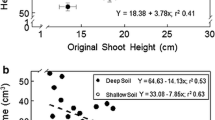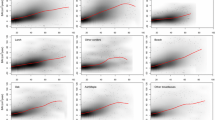Abstract
A common objective in commercial reforestation is to plant seedlings that will produce superior adult trees. Long forest management planning horizons and life spans of most forest trees complicate the prediction of growth and performance of adult trees originating from planted seedlings of unknown genetic origin. We used multivariate statistics to identify and rank a set of seedlings characteristics that could predict the performance of mature trees in Pinus ponderosa. Results indicated that metabolic heat rate (q), a measure of total metabolism, of one-year-old foliage during the peak growth in May, was the most important seedling characteristic that predicted mature-tree performance. Increased metabolic heat rate in seedlings corresponded with greater vigor of mature trees. Additionally, seedling basal stem diameter (D), height (H), and needle length (NL), measured in November, were, in order of importance, other variables that defined the vigor class of the mature clones. However, these seedling morphological characteristics correlated negatively with vigor classification of the mature clones, contradicting the notion that greater D and/or H during the seedling stage may indicate a greater vigor at maturity.
Similar content being viewed by others
References
Anderson P.D., Houpis J.L.J., Helms J.A. and Momen B. 1997. Seasonal variation of gas exchange and pigmentation in branches of three grafted clones of mature ponderosa pine exposed to ozone and acid rain. Environ. Pollut. 97: 253–263.
Anekonda T.S., Criddle R.S., Libby W.J., Breidenbach R.W. and Hansen L.D. 1994. Respiration rates predict differences in growth of coast redwood. Plant Cell Environ. 17: 197–203.
Anekonda T.S., Criddle R.S., Bacca M. and Hansen L.D. 1999. Contrasting adaptation of two Eucalyptus subgenera is related to differences in respiratory metabolism. Funct. Ecol. 13: 675–682.
Criddle R.S., Breidenbach R.W., Lewis E.A., Eatough D.J. and Hansen L.D. 1988. Effects of temperature and oxygen depletion on metabolic rates of tomato and carrot cell cultures and cuttings measured by calorimetry. Plant Cell Environ. 11: 695–701.
Criddle R.S., Anekonda T.S., Tong S., Church J.N., Ledig F.T. and Hansen L.D. 2000. Effects of climate on growth traits of river red gum are determined by respiration parameters. Aust. J. Plant Physiol. 27: 435–443.
Cruze-Castillo J.G., Ganeshanandam S., Mackay B.R., Lawes G.S. and Woolley D.J. 1994. Application of canonical discriminant analysis in horticultural research. HortScience 29: 1115–1119.
Fincher J. 1992. Comparison of structural changes in red spruce during cold hardening in mature trees and seedlings used in pollution exposure studies. Forest Ecol. Manag. 51: 105–113.
Hansen L.D., Lewis E.A., Eatough D.J., Fowler D.P. and Criddle R.S. 1989. Prediction of longterm growth rates of larch clones by calorimetric measurement of metabolic heat rates. Can. J. Forest Res. 19: 606–611.
Hansen L.D., Woodward R.A., Breidenbach R.W. and Criddle R.S. 1992. Dark metabolic heat rates and integrated growth rates of coast redwood clones are correlated. Thermochem. Acta 211: 21–32.
Hansen L.D., Hopkin M.S. and Criddle R.S. 1997. Plant calorimetry: a window to plant physiology. Thermochim. Acta 300: 183–197.
Hemming D.J.B., Mayer S.E., Smith B.N. and Hansen L.D. 1999. Respiration characteristics differ among cheatgrass (Bromus tectorum L.) populations. Great Basin Nat. 59: 355–360.
Huberty C.J. 1994. Applied Discriminant Analysis. John Wiley and Sons, Inc., New York, USA.
Jones H.G. 1992. Plants and Microclimate. 2nd edn. Cambridge University Press, Cambridge, USA, 428 pp.
Larcher W. 1995. Physiological Plant Ecology. 3rd edn. Springer-Verlag, Berlin, 506 pp.
Matthew C., Lawoko C.R.O., Korte C.J. and Smith D. 1994. Application of canonical discriminant analysis, principal component analysis, and canonical correlation analysis as tools for evaluating differences in pasture botanical composition. New Zeal. J. Agr. Res. 37: 509–520.
Momen B. 1993. An investigation of the effects of simulated acid rain and elevated ozone on the physiology of ponderosa pine (Pinus ponderosa Dougl. Ex Laws.) seedlings and mature trees. Ph.D. dissertation, University of California Berkeley, CA, USA.
Momen B., Helms J.A. and Criddle R.S. 1996. Foliar metabolic heat rate of seedlings and mature trees of Pinus ponderosa exposed to acid rain and ozone. Plant Cell Environ. 19: 747–753.
Pye J.M. 1988. Impact of ozone on the growth and yield of trees: a review. J. Environ. Qual. 17: 347–360.
Rencher A.C. 1992. Interpretation of canonical discriminant functions, canonical varieties, and principal components. Am. Stat. 46: 217–225.
SAS/STAT User's Guide. 1992. SAS Institute Inc., SAS Campus Drive, Cary, NC, 27513.
Salisbury F.B. and Ross C.W. 1985. Plant Physiology. Wadsworth, Inc., Belmont, CA, USA.
Smith B.N., Monaco T.A., Hemming D.J.B., Hansen L.D. and Criddle R.S. 1996. The relation between respiration and growth rates of accessions of plants of Great Basin, United States. Russ. J. Plant Phys. 43: 821–825.
Smith B.N., Jones A.R., Hansen L.D. and Criddle R.S. 1999. Growth, respiration rate, and efficiency responses to temperature. In: Pessarakli M. (ed), Handbook of Plant and Crop Stress. Marcel Dekker, Inc., New York, USA, pp. 417–440.
Smith B.N., Criddle R.S. and Hansen L.D. 2000. Plant growth, respiration and environmental stress. J. Plant Biol. 27: 89–97.
Teskey R.O., Dougherty P.M. and Wiseloge A.E. 1991. Design and performance of branch chambers suitable for long-term fumigation of foliage in large trees. J. Environ. Qual. 20: 591–595.
Zobel B. and Talbert J. 1984. Applied Forest Tree Improvement. John Wiley and Sons, New York, USA.
Author information
Authors and Affiliations
Corresponding author
Rights and permissions
About this article
Cite this article
Momen, B., Anderson, P., Sullivan, J. et al. A multivariate statistical approach to predicting mature tree performance based on seedling characteristics. New Forests 27, 303–313 (2004). https://doi.org/10.1023/B:NEFO.0000022226.95493.d7
Issue Date:
DOI: https://doi.org/10.1023/B:NEFO.0000022226.95493.d7




